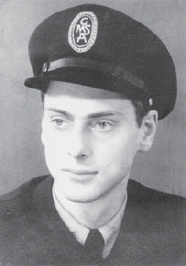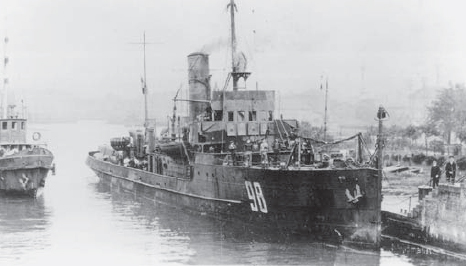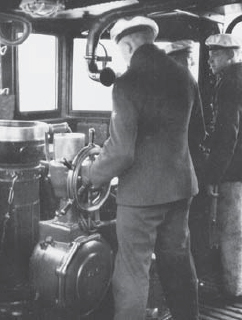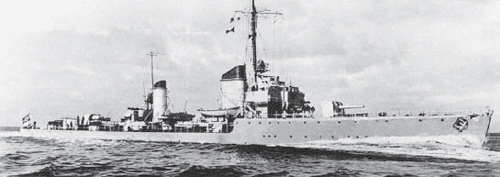
To British and American ears the term torpedo boat conjures up images of the MTB (Motor Torpedo Boat) or PT-boat (Patrol Torpedo Boat) – a small, fast, motor-launch type of vessel relying on its high speed to survive attacks on enemy shipping. Nothing could be further removed from the reality of a German Torpedoboote, which in fact was a small destroyer akin to the US Destroyer Escort.

This petty officer, a former member of the Kriegsmarine, has gone on to serve in the post-war mine clearing service supervised by the British. In this case Kriegsmarine insignia have been removed from his uniform, and he wears a badge bearing the initials ‘GMSA’ for German Mine Sweeping Administration. (Deutsches U-Boot-Museum)

It is interesting to note that it was not only some of the newer minesweeper types that survived the war, but several of the older pre-war models too. This photograph taken in 1946 shows an older vessel, still in its original black colour scheme, being used by the GMSA. (Deutsches U-Boot-Museum)
On the outbreak of war the bulk of the Kriegsmarine’s torpedo boat fleet was made up of vessels that had been built in the second half of the 1920s and were already somewhat dated. All were built at the Marinewerft in Wilhelmshaven; the first batch of six were designated as the ‘Raubvogel’ (Wild Bird) class, and named accordingly as follows: Möwe (Seagull), Seeadler (Sea Eagle), Greif (Griffon Vulture), Albatros, Kondor and Falke (Falcon). A second batch of six, the ‘Raubtier’ (Wild Animal) class, consisted of the following: Wolf, Iltis (Polecat), Luchs (Lynx), Tiger, Jaguar and Leopard.
Despite various improvements and refits it was clear that a more modern type would be required, and in 1935 a new design was approved for construction. Between 1936 and 1942 a total of 21 of these M35 types (including an improved but basically similar variant introduced in 1937) were built. This class were not named but identified by a pennant number prefixed with ‘T’ for Torpedoboot:
| Shipyard | Vessels | Total |
| Schichau, Elbing | T1–4, T9–10, T13–21 | 15 |
| Deschimag, Bremen | T5–6, T11–12 | 6 |
There were nine torpedo boat flotillas numbered sequentially 1–7 and 9–10, the 8th Flotilla never becoming operational. Their deployment was as follows:
| Flotilla | Deployment |
| 1. Torpedobootflottille (formed pre-war) | 1939–April 1941: North Sea and English Channel April–Aug 1941: Baltic Aug 1941: Stood down |
| 2. Torpedobootflottille (formed pre-war) | 1940–41: Operational in Channel 1941: Operational in Baltic 1942–43: Defensive minelaying in Western waters 1943–44: Training flotilla 1944–45: Escort service in Baltic |
| 3. Torpedobootflottille (formed April 1941) | 1941–42: Working-up and training exercises 1942: Minelaying in Western waters 1943–44: Training duties with Torpedo School, and combined operations with U-boats in Baltic 1944–45: Patrol and security duties in eastern Baltic and Skagerak |
| 4.Torpedobootflottille (formed Feb 1943) | 1943–44: Minelaying and escort duties in Western waters Apr 1944: Stood down |
| 5. Torpedobootflottille (formed pre-war) | 1939–40: Defensive minelaying, escort duties and anti-shipping operations in Western waters 1940: Invasion of Norway; escort and security duties in Skagerak 1941–44: Escort duties; offensive and defensive minelaying in Western waters 1944: Based on French Channel coast; all ships destroyed during Normandy invasion campaign 1944–45: Re-formed; served in Finnish waters and eastern Baltic escorting evacuation operations |
| 6. Torpedobootflottille (formed pre-war) | 1939–40: Minelaying, escort and anti-shipping operations in Western waters 1940–41: Security and escort duties during invasion of Norway; minelaying and escort duty Feb 1941: Stood down |
| 7. Torpedobootflottille (formed Nov 1943) | 1943–44: Operational in Finnish waters, and defensive minelaying in Baltic Aug 1944: Stood down |
| 9. Torpedobootflottille (formed late summer 1943) | 1943–44: Operational in Aegean Oct 1944: Stood down |
| 10. Torpedobootflottille (formed Jan 1944) | 1944–45: Operational in Mediterranean |
All these torpedo boats were active during the Spanish Civil War as part of Germany’s ‘non-intervention’ patrols. All vessels of both classes were also involved in escort work for the invasion fleet during the attack on Norway in April 1940. By the end of that campaign four of the 12 vessels had been lost, and the remaining eight were thereafter grouped together in 5. Torpedobootsflottille. During the second half of 1940 the flotilla was heavily involved in minelaying operations in the English Channel, and also in ‘hit and run’ attacks on British merchant shipping.
Five of these warships – Seeadler, Kondor, Falke, Iltis and Jaguar – were also involved in Operation ‘Cerberus’ (the ‘Channel Dash’), escorting the battleships Scharnhorst and Gneisenau and the heavy cruiser Prinz Eugen during their run eastwards through the English Channel in February 1942; Jaguar was severely damaged by British aircraft during this operation. On 14/15 May 1942, Seeadfler, Iltis, Kondor and Falke formed part of the escort screen for the auxiliary cruiser Stier as she broke out into the Atlantic through the Channel. The German ships came under fire from both long-range coastal artillery at Dover and from British MTBs, and both Iltis and Seeadler were sunk.

This pre-war shot shows the 1920s vintage torpedo boat Albatros (identified by the letters ‘AT’ on the bow) sporting the typical black paint scheme widely used on smaller vessels pre-war. The crew lined up for this photo seem to be 56 ratings in whites, 11 petty-officers in blue jackets and white trousers, and five officers in blue uniforms – about half her complement. (Author’s collection)
The remainder of these elderly boats continued to give good service until the summer of 1944, when they were all destroyed in Allied bombing raids conected with the Normandy invasion. The individual fates of the M23 and M24 class were as follows:
| Vessel | Launched | Commissioned | Fate |
| Möwe | March 1926 | Oct 1926 | sunk at moorings in Le Havre during air raid, 15 June 1944 |
| Seeadler | July 1926 | May 1927 | sunk in action with British MTBs in the Channel, 13 May 1942 |
| Albatros | July 1926 | May 1927 | beached May 1940 after being crippled by Norwegian coastal artillery |
| Greif | July 1926 | March 1927 | sunk in Seine estuary during air raid, 23 May 1944 |
| Kondor | Sept 1926 | July 1927 | sunk at moorings in Le Havre during air raid, 31 July 1944 |
| Falke | Sept 1926 | Aug 1927 | sunk at moorings in Le Havre during air raid, 15 June 1944 |
| Wolf | Oct 1927 | Nov 1928 | sunk by British mine off Dunkirk, 8 January 1941 |
| Iltis | Oct 1927 | Oct 1928 | sunk in action with British MTBs in the Channel, 13 May 1942 |
| Luchs | March 1928 | April 1929 | sunk in North Sea by British submarine HMS Swordfish, 26 July 1940 |
| Tiger | March 1928 | Jan 1929 | sunk in collision with German destroyer Max Schulz, 25 August 1939 |
| Jaguar | March 1928 | June 1929 | sunk at moorings in Le Havre during air raid, 15 June 1944 |
| Leopard | March 1928 | June 1929 | sunk in collision with German minelayer Preussen, 1 April 1940 |
The more modern torpedo boat designs were certainly more stylish in appearance that their elderly forerunners, but the use of high-pressure turbines as fitted in the larger German destroyers resulted in their suffering similar technical problems. They were also poor seagoing vessels, and could not be used for minelaying except in calm weather; one of their perceived positive points had been their anticipated ability to carry out high-speed, short-range minelaying sorties. In addition to their other shortcomings, they also had relatively light armament. Most of them were relegated to non-combat duties, assigned to U-boat training flotillas in the Baltic.

A helmsman at the wheel on the bridge of a torpedo boat. This area was far from spacious, and the dark colour scheme must have made visibility somewhat problematic during the hours of darkness. (Deutsches U-Boot-Museum)
The M35 torpedo boats first became operational in late 1940 with 1. Torpedobootsflottille, which had been created a year earlier; it had taken this length of time to deliver the boats allocated to the flotilla in serviceable condition following numerous powerplant failures.
This flotilla was disbanded in August 1941; during its short life T1 was severely damaged after running aground, T2 had to spend several months in dock for repairs when she was damaged by a bomb dropped by a British aircraft while escorting a minelaying mission; T3 was sunk during a bombing raid on Le Havre (though she was later raised); and T6 was lost when she ran onto a mine.
The 2. Torpedobootsflottille began operations in the summer of 1940. Shortly after the flotilla moved to France, T11 was severely damaged in a bombing attack and subsequently spent several months in repair dock. Availability of operational boats was a constant problem, since regular visits to the dockyard for repairs were required. The flotilla did perform some useful tasks, particularly in the escort role, and was involved in the successful ‘Channel Dash’; but from mid 1943 to mid 1944 no operational sorties were undertaken. T2 and T4 were sunk during a bombing raid on Bremen, and although refloated they never returned to service. Although T3 did succeed in sinking a Soviet submarine in January 1945, the late stages of the war were spent on escorting convoys in the Baltic; during one such mission both T3 and T5 were sunk by mines laid by a Soviet submarine.
The largely unsuccessful M35 class would be followed by an even larger type known as the M39 or Fleet Torpedo Boats (Flotten-Torpedoboote). Construction was again shared between Schichau and Deschimag, but in the event only the batch of 16 awarded to the Schichau yard at Elbing were completed, and numbered T22–36.
| Specifications – M39 Flottentorpedoboot: | |||
| Length | 102.5m | Top speed | 30 knots |
| Beam | 10m | Endurance | 2,400 nautical miles |
| Displacement | 294 tons | Crew | 198 |
| Armament | 4x 10.5cm guns, 4x 3.7cm flak, 2x 2cm flak; 6x torpedo tubes; 4x depth charge launchers; up to 50 mines | ||
After the problems suffered by the M35/37 type the M39 ‘Elbing’ class boats were a massive improvement, and true multi-role warships rather than simply torpedo boats. Bigger and heavier than their predecessors, this class was almost a hybrid between the smaller torpedo boats and the larger destroyers; they were seaworthy, fast and highly manoeuvrable. Much of the work performed by this class was on escort duties and they were certainly capable of giving a good account of themselves. Since most of the ports in the West had been lost by the time the last five were commissioned, those spent their active careers in the Baltic.
 |
TORPEDO BOATS 1: Raubvogel class |
| Shown here in its early 1930s form, this torpedo boat is finished in the typical black early colour scheme. The foremost and sternmost open gun mounts have been replaced by enclosed turrets; the raised stern mount – only marginally more protected in heavy seas – is still open to the elements. By the late stages of the war the surviving members of this early class of torpedo boats had all of their main armament in turrets, carried radar antennae on both masts, and mounted increased anti-aircraft armament. | |
| 2: M39 Flottentorpedoboot | |
| The more rakish lines of this class are evident. Note the additional main armament turret mounted admidships, giving this type a total of four 10.5cm guns – as many as some full-size destroyers. Anti-aircraft armament consisted of two twin 3.7cm guns as well as single and quadruple 2cm flak mounts. With two triple torpedo tubes, these were very powerfully armed for small warships. | |
| (Details, left) Typical open gun mount found on the early torpedo boats. The weapon is a 10.5cm L/45, introduced in 1932 but based on a design dating back to before World War I. It had a rate of fire of 15 rounds per minute, firing a 24kg shell at a muzzle velocity of 780 metres per second. | |
| (Details, right) Now enclosed in a turret, the main armament fitted to later types of torpedo boat – the 10.5cm L/45 C/32 – was basically the same as the earlier piece. Note the raised armoured flap, dropped when not in use to protect the delicate sighting optics. |


A Raubvogel class torpedo boat in pale grey livery, a scheme carried by almost all Kriegsmarine vessels by 1939. The identifying letters are no longer displayed on the bow. (Deutsches U-Boot-Museum)
In Western waters in late 1943 the Elbings were involved in escorting a blockade-runner carrying a cargo of critically important war material back home to Germany from Japan. The convoy was attacked by the British light cruiser HMS Charybdis, accompanied by a number of destroyers. The German torpedo boats immediately went on to the offensive and launched torpedoes at the British cruiser; at least two hit their target, leaving the warship dead in the water. Torpedoes were also launched at the accompanying destroyers, scoring a direct hit on HMS Limbourne. The remaining British warships withdrew, and the German convoy reached port unscathed. The Royal Navy had learned a hard lesson about the potential of these powerful torpedo boats. Only when they decided to have their cruisers stand off and direct the faster destroyers by radar, whilst using their own heavy guns against the torpedo boats at long range, did they achieve greater success. The fate of individual boats of the M39 class was as follows:
| Vessel | Commissioned | Fate |
| T22 | Feb 1942 | sunk 18 August 1944 with loss of 143 crew when she ran onto one of her own mines |
| T23 | June 1942 | survived the war; taken into service by the British in 1946 |
| T24 | Oct 1942 | sunk with loss of 18 crew by British air attack, 24 August 1944 |
| T25 | Dec 1942 | sunk with loss of 85 crew during engagement in Bay of Biscay with British destroyers HMS Glasgow and Enterprise, 28 December 1943 |
| T26 | Feb 1943 | lost with 90 crew in same engagement as T25 |
| T27 | April 1943 | ran aground after engagement with Canadian destroyer off Breton coast, later destroyed by Allied aircraft; most of her crew survived |
| T28 | June 1942 | survived the war; taken into service by the British in 1945 |
| T29 | Aug 1943 | sunk with loss of 137 crew by gunfire and torpedoes from British cruiser HMS Black Prince and destroyers HMS Haida, Huron, Ashanti and Athebascan, 26 April 1944 |
| T30 | Oct 1943 | sunk with loss of 114 crew when she ran into German minefield, 18 August 1944 |
| T31 | Feb 1944 | sunk with loss of 82 crew by torpedo from Soviet MTB, 20 June 1944 |
| T32 | May 1944 | sunk with loss of 137 crew when she ran into German minefield, 18 August 1944 (see T30) |
| T33 | June 1944 | survived the war; taken into service by the Soviet Navy |
| T34 | Aug 1944 | sunk with loss of 62 crew off Cap Arcona by torpedo from Soviet submarine L3, 20 November 1944 |
| T35 | Oct 1944 | survived the war; taken into service by US Navy |
| T36 | Dec 1944 | sunk with loss of 63 crew by mine and Soviet aircraft off Usedom, 4 May 1945 |

The more rakish appearance of the M39 Elbing class Flottentorpedoboot was not deceptive; this class were a great improvement on their predecessors, being excellent sea-boats and heavily armed. However, only 16 were ever built, and the last five delivered were limited to operations in the Baltic through the earlier loss of Western ports in 1944. (Deutsches U-Boot-Museum)
Britain, the USA, France, the USSR and Denmark all made good use of captured torpedo boats post-war. As well as German-built torpedo boats a number of captured ships – predominantly Norwegian, French and Italian – were also taken into service by the Kriegsmarine, the French and Italian vessels being predominantly used in the Mediterranean with the majority being lost in action.